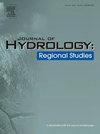利用 HBV-Light 半分布式概念水文模型估算埃塞俄比亚阿瓦什河流域上游的地下水补给量
IF 4.7
2区 地球科学
Q1 WATER RESOURCES
引用次数: 0
摘要
研究区域位于埃塞俄比亚中部的阿瓦什河流域上游地区研究重点在本文中,我们使用半分布式概念水文 HBV-Light 模型估算了地下水补给量。我们使用的计量和流量数据分别来自埃塞俄比亚计量局和水利能源部。为了模拟 1988 年至 2015 年参考期内的地下水补给情况,我们将这些数据与 HBV-Light 概念降雨-径流模型进行了合并,以进行校准和验证。1986 年至 2015 年的年平均降水量为 1117 毫米。在 20 年的校准期内,多个参数值的观测结果与模型流量相当。除了大多数参数外,其他参数的模拟结果都很好,参数值的变化范围很大。少数参数定义明确(即最佳参数值在有限范围内)。我们还采用了区域敏感性分析(RSA)方法来评估模型参数和模型的敏感性。模型参数的选择采用了 HBV-light 和广义似然不确定性估计方法。结果表明,计算得出的蒸散量占降水量的 79.5-80%。Awash Melkakuntiro 和 Hombele 的计算补给率分别为 220.8 毫米/年和 212.01 毫米/年。因此,研究区域的年平均补给量为全年降水量的 216(19.6%)。研究发现,地下水资源的可用性与当前的补给率密切相关。为提高地下水补给估算的准确性,采用了 HBV-Light 模型。研究建议通过扩大水文气象数据库和整合每日补给计算的实时数据来提高数据的一致性和质量。本文章由计算机程序翻译,如有差异,请以英文原文为准。
Utilizing the HBV-Light semi-distributed conceptual hydrological model to estimate groundwater recharge in the upstream part of the Awash River basin, Ethiopia
Study region
Upstream part of the Awash River basin, located central part of Ethiopia
Study focus
In this paper, we estimated the groundwater recharge using a semi-distributed, conceptual hydrological HBV-Light model. We used metrological and flow data from the Ethiopia Metrological Agency and the Ministry of Water and Energy, respectively. To simulate groundwater recharge over the reference period from 1988 to 2015 we merged these data with the conceptual HBV-Light rainfall-runoff model for calibration and validation. The average yearly precipitation from 1986 to 2015 was 1117 mm. Two calibration situations are examined to determine the level of uncertainty using a Monte Carlo approach with randomly generated parameter values.
New hydrological insights for the region
For a 20-year calibration period, several parameter values were observed and modeled flow equally well. Except for most parameters, good simulations were discovered with values that varied across vast ranges. A few parameters were well-defined (i.e., the optimum parameter values were within limited ranges). We also employed the regional sensitivity analysis (RSA) method to assess the sensitivity of model parameters and model. HBV-light and the generalized likelihood uncertainty estimation method were used for selecting its parameters. The results indicate that the calculated evapotranspiration is 79.5–80 % of the precipitation. Awash Melkakuntiro and Hombele’s calculated recharge rates are 220.8 mm/yr and 212.01 mm/yr, respectively. Thus, the average annual recharge for the study area is 216 (19.6 %) of the yearly precipitation. The study found that groundwater resource availability is strongly linked to current recharge rates. To improve the accuracy of groundwater recharge estimation, the HBV-Light model was employed. The study recommends enhancing data consistency and quality by expanding the hydrometeorological database and integrating real-time data for daily recharge calculations.
求助全文
通过发布文献求助,成功后即可免费获取论文全文。
去求助
来源期刊

Journal of Hydrology-Regional Studies
Earth and Planetary Sciences-Earth and Planetary Sciences (miscellaneous)
CiteScore
6.70
自引率
8.50%
发文量
284
审稿时长
60 days
期刊介绍:
Journal of Hydrology: Regional Studies publishes original research papers enhancing the science of hydrology and aiming at region-specific problems, past and future conditions, analysis, review and solutions. The journal particularly welcomes research papers that deliver new insights into region-specific hydrological processes and responses to changing conditions, as well as contributions that incorporate interdisciplinarity and translational science.
 求助内容:
求助内容: 应助结果提醒方式:
应助结果提醒方式:


